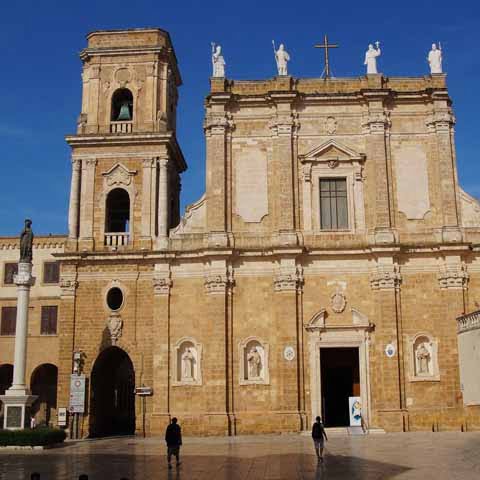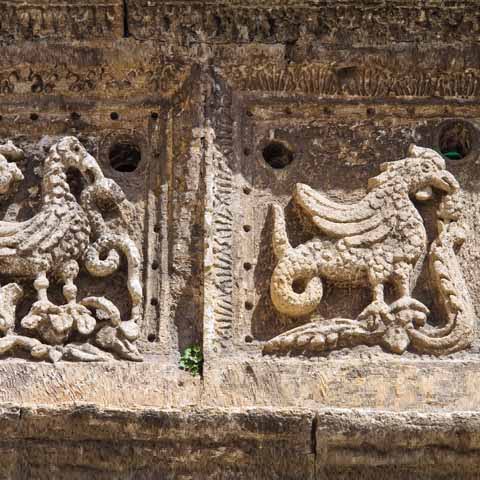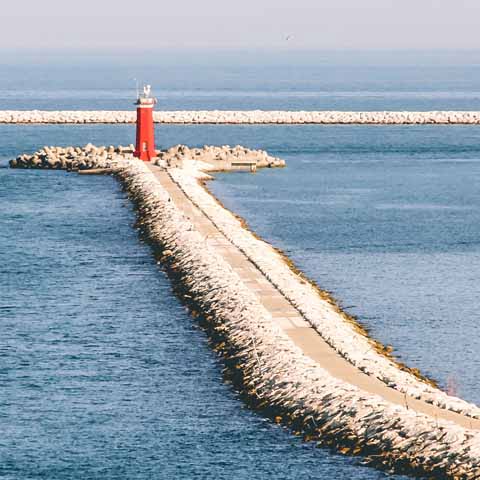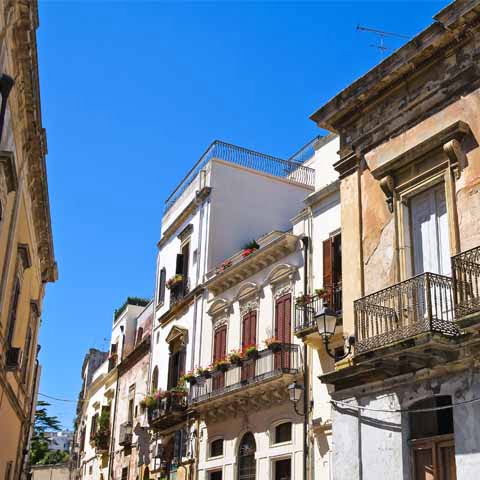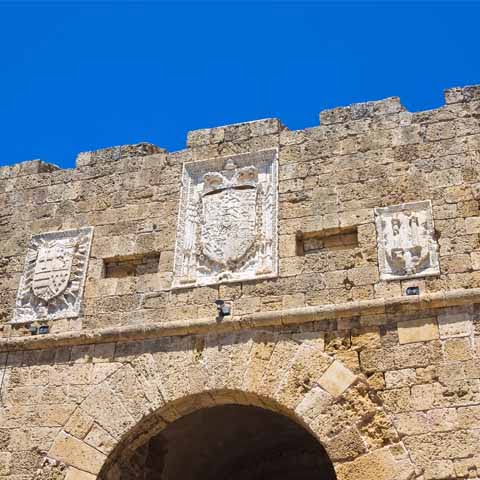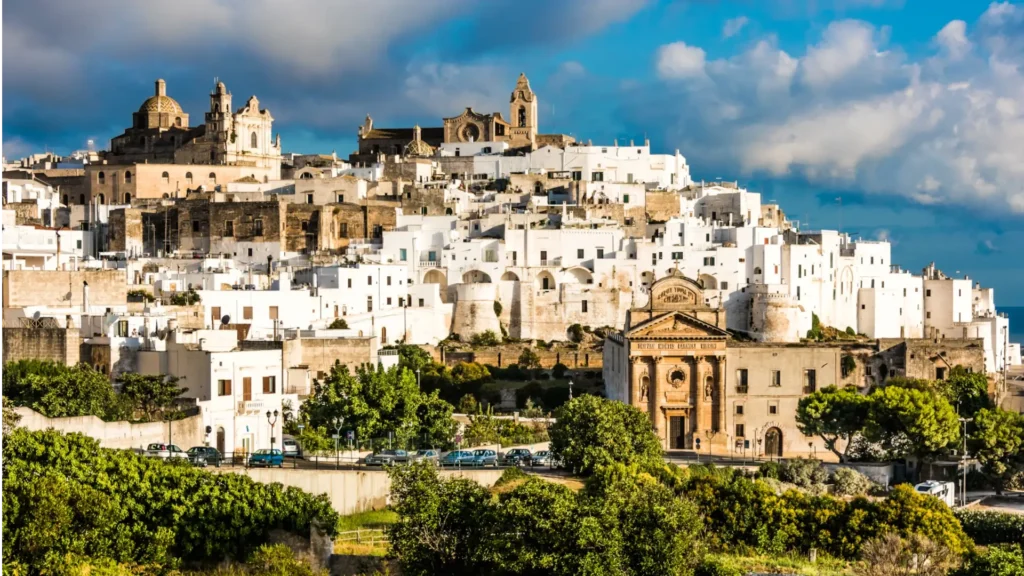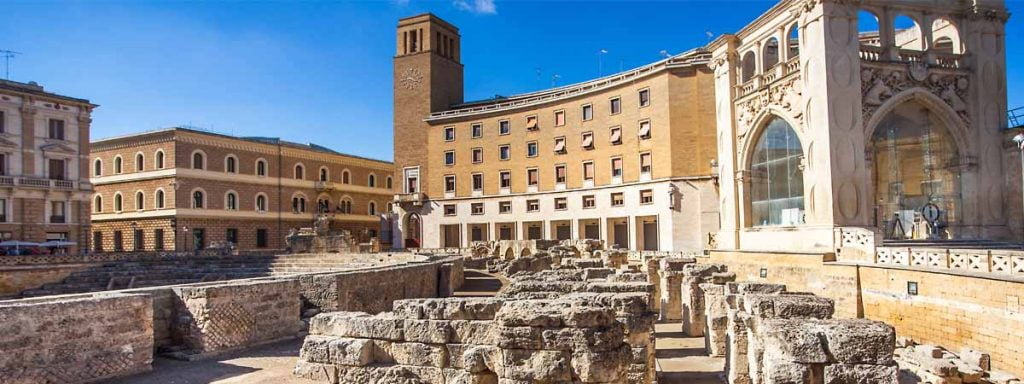In Southern Italy lies the beautiful port city of Brindisi. On the east side of the country, facing the Adriatic coast, this ancient city is a quintessential part of Italy. With bright white boats of all sizes sailing through the calm blue waters of the harbor, the landscape of the town itself is a painter’s dream. The ancient roots and traditions of this seaside city are the true heartbeat of Brindisi’s culture.
ARCHITECTURE
Much of the city’s architecture is evidence of the city’s historic Greek, Roman, and medieval influences.
The magnificent structure referred to as the Roman Column is made of marble and rises sixty-two feet into the city’s skyline. The column stands at the center of an open air square close to the port with a wide stairway leading up to it. The Brindisi structure is actually one of two original columns. The other column was donated to Lecce and can be seen there today. The column, which was originally built by the Romans to mark the end of the Appian Way, has become a symbol of Brindisi.
The Monument to Italian Sailors stands at the water’s edge and is dedicated to the fallen. The structure itself is often called “The Rudder” because it so closely resembles the actual rudder of a ship. It was erected in the early twentieth century and rises over one hundred seventy feet. Visitors usually have the opportunity to climb six circular staircases to reach the top of the tower for a beautiful aerial view of Brindisi.
The Church of San Benedetto is actually a complex comprised of a church, cloister, and monastery. The eleventh century complex features definitive Romanesque elements. The exterior is largely unassuming with one massive bell tower on the side. The interior of the church is stunning with a central nave, one main center aisle, several white columns, and a beautiful arched brick design on the ceiling. The square features many simple arched walkways which offer a lovely place of respite from the busy port area.
The Church of Santa Maria del Casale is a thirteenth century medieval structure that has experienced restoration over the years. Although the Romanesque and Gothic style church is mostly a basic rectangular shape, the front exterior is covered in panels of various designs made with alternating types of stone, one light in color and one much darker. The entrance to the church is covered by an ornate and intricately designed overhang above the main door. The interior is one central main aisle that leads up to the altar through several arched ceiling openings. As you proceed up the aisle, a number of beautiful frescoes cover the walls. Some of the more impressive frescoes here include the Last Judgement, the Annunciation, and Madonna with Child.
The Church of San Giovanni al Sepolcro is unique for its circular shape. The Romanesque style eleventh century building also has an ornate overhang above the main entry way that is braced on either side by large stone columns that sit atop two sculptures. The circular interior is comprised of a light-colored stone, several frescoes, and a beautiful network of white columns that support giant archways throughout. Two of the more well-known frescoes in Chiesa San Giovanni al Sepolcro include the Deposition of the Christ and the Madonna and Child. The church is unlike any of the others you will see in Brindisi.
The Pontificia Basilica Cattedrale, often referred to as the Brindisi Cathedral is located centrally and is considered to be the main structure of the city. Construction began by Pope Urban II in the eleventh century and the church was completed in the twelfth century. Today it sits on a square next to several other buildings. The Romanesque exterior is comprised of a light-colored stone with arched entryways to the side of the main door and arched lookouts from the bell tower. White statues are seemingly carved into the exterior of the building and several more sit on top of the building on either side of a small cross. The interior of the building features one main aisle that sits between close to half a dozen large and ornate white pillars that stretch the length of the aisle. A gorgeous circular stained-glass window sits above the altar.
Another beautiful church worth a visit is the Church of San Paolo Eremita, which was completed during the fourteenth century. The church is a rare example of the Gothic Apulian architectural style. The current façade was actually rebuilt during the eighteenth century in order to prevent the original façade from collapsing. Inside, travelers can marvel at the beautiful Baroque altars.
ART
There are countless works of art and monuments throughout the city that attest to Brindisi’s artistic tradition. Among these is the medieval Church of the Santissima Trinità (also known as the Church of Santa Lucia). Dating back to the twelfth century, the church was constructed in the Romanesque style. Of particular interest is the crypt, dated to the thirteenth century, that features a remarkable grouping of frescoes depicting various saints including Saint Nicholas, Saint Blaise, and Saint Peter.
While exploring the city center, be on the lookout for the Monument to Virgil, which was added to Piazza Vittorio Emanuele II towards the end of the twentieth century. Dedicated to the famed Roman poet that died in Brindisi, the beautiful monument depicts a winged figure representing Victory. The base of the monument features thematic symbols of Virgil’s poetry, such as a helmet and olive branch.
Also of note is Tancredi’s Fountain, which was originally a Roman fountain. It was rebuilt several times, first during the twelfth century by Norman King Trancredi, then in the sixteenth century, and finally in the nineteenth century when it was also enlarged. Today the fountain consists of several spouts, including two at each end that are protected by covered arches. Several historic elements remain, including two masks that date back to the twelfth century.
For ancient art, head to the Francesco Ribezzo Archeological Museum. Located in Piazza Duomo, the museum features ancient statues found in Brindisi and the surrounding area (including bronze sculptures) as well as prehistoric artifacts, ancient coins, and medieval objects.
Another museum worth a visit is the Museo Etnico della Civiltà Salentina, or the Museum of the Salentine Civilization. The museum houses several wood and stone statues that represent the local agriculture as well as historic instruments once used by local farmers.
LITTERATURE
Roman poet and dramatist Marcus Pacuvius was born in Brindisi, called Brundisium at the time, in 220 BC. He frequently wrote plays about mostly Greek subjects and occasionally dabbled as a painter, though he was better known for his written works.
LITERATURE
Roman poet and dramatist Marcus Pacuvius was born in Brindisi, called Brundisium at the time, in 220 BC. He frequently wrote plays about mostly Greek subjects and occasionally dabbled as a painter, though he was better known for his written works.
MUSIC
Celebrated twentieth century pianist and conductor Stefano Miceli was born in Brindisi and has played at a number of prestigious venues including Carnegie Hall in New York City. He often works with various orchestras and conductors. Miceli was awarded a silver medal in 2008 by the President of Italy in recognition of his outstanding performances and ongoing dedication to education.
CINEMA
As a whole, the city is relatively unknown to the world of cinematography as a setting for films, but cinema is still an important part of culture in Brindisi.
Giustino Durano, a twentieth century actor born in Brindisi, is known for playing Eliseo Orefice in the 1997 film Life Is Beautiful, which won three Academy Awards.
In 1998, Brindisi served as the setting for the Italian film Aprile directed by Nanni Moretti.
SCIENCE
Brindisi is home to a research center for the Italian National Agency for New Technologies, Energy, and Sustainable Economic Development. Known as ENEA, the agency has its headquarters in Rome, while the center in Brindisi focuses on research in sustainable energy and technological innovations.
Lose yourself in the architectural beauty of Brindisi’s churches and monuments and the natural aesthetics of the bustling harbor off of the Adriatic Sea. In many ways, to witness the life and activity of Brindisi is to experience art in one of its truest forms.
Travel Guides
The Apulia Region of Italy
The Cities of Apulia, Italy
